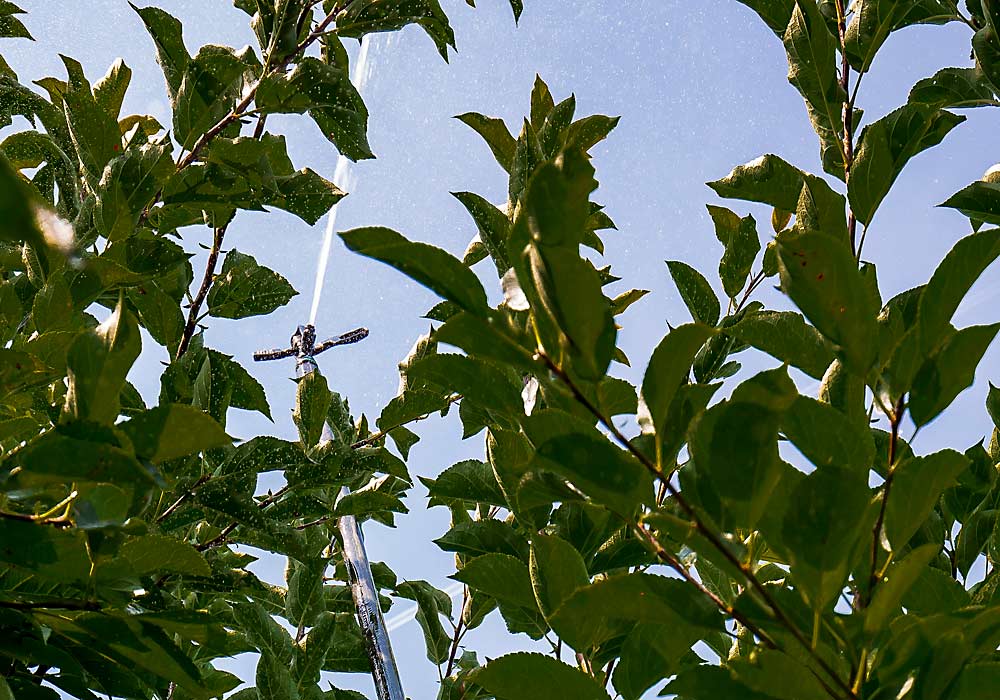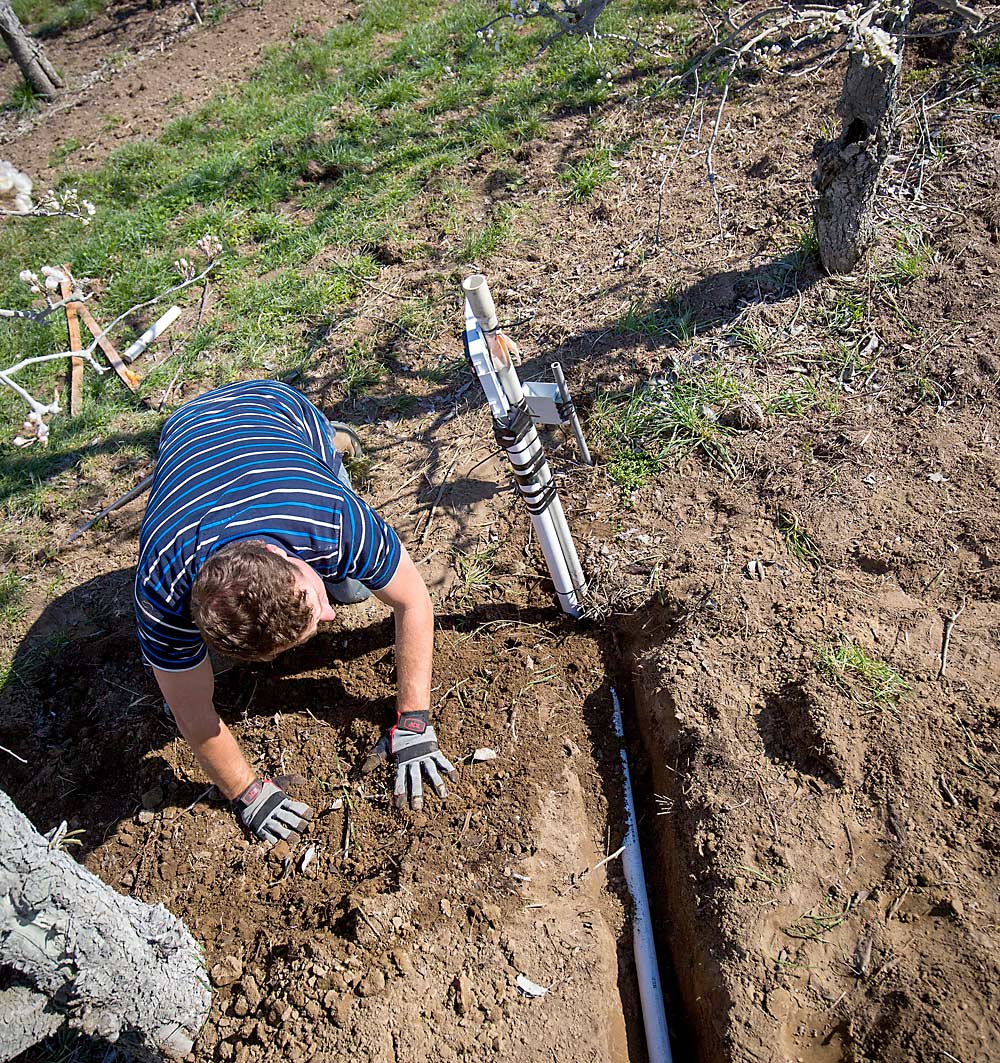
When it comes to controlling vigor, many growers think about pruning, training and plant growth regulators, but in arid regions of the U.S., irrigation is an underappreciated tool in the same box.
Plentiful water supports larger fruit development in some varieties, but in others, water stress appears to reduce development of disorders such as bitter pit. Precision irrigation plans can help manage variable soils and improve fruit quality.
“Irrigation water is a huge opportunity. It’s about hitting the target, not just filling that soil tank and keeping it full,” said physiologist Lee Kalcsits. The Washington State University professor spoke about using water to manage vigor at the Washington State Tree Fruit Association’s annual meeting in Yakima, Washington, in December, including some insight into his recent research using deficit irrigation to reduce bitter pit in Honeycrisp.
A panel of growers and irrigators followed Kalcsits, sharing insights and experiences on how manipulation of irrigation has benefitted them in different cultivars.
“There is a lot of opportunity in using water to affect growth and cropping, but it’s a dangerous tool,” said panelist Mike Stewart of Stewart Irrigation Consulting in Quincy, Washington.
He recommended using both soil moisture sensors and the old-fashioned method. “Y’all should be feeling your dirt,” he said. “We’ve got a lot of variable soils, so you need to feel it.”
Panelist Chris Peters, orchard manager for Valley Fruit Orchards in Royal City, Washington, said that his understanding of irrigation — and the industry’s — has come a long way from the approach his dad relied on: 24 hours of water for every block. New technology drives some of that change, but finicky cultivars such as Honeycrisp inspired growers to experiment more as well, he said.
“I think 85 percent of what we do is water, so it’s important to get it right,” Peters said. “Playing around with water has made me a better farmer.”
Bitter pit deficit

Kalcsits began to explore deficit irrigation to control bitter pit in Honeycrisp, recognizing that larger fruit seems to be more susceptible to the disorder driven by the lack of calcium. Water stress during fruit development might keep the fruit and fruit cell size smaller and reduce the risk, he thought.
Moreover, the plant’s water use drives calcium movement. Unlike most plant-mobile nutrients, “calcium follows the water stream,” Kalcsits said. Since leaves transpire a lot and fruit doesn’t, not enough of the calcium ends up where it’s needed for fruit cell walls.
For the study, he compared early-, middle- and late-season deficits on fruit size and bitter pit development in a young block (third leaf in 2017) that had high rates of bitter pit.
“Early water stress increased bitter pit in ’17 but lowered it in ’18, probably due to weather differences,” Kalcsits said. “But midseason and late-season deficits dropped bitter pit in both years, because it slowed shoot growth and limited fruit size.”
Water stress actually performed better than using PGRs to control vigor. That’s because Apogee (prohexadione calcium) shrinks internode length on shoots, but there are still just as many leaves competing for calcium, they are just closer together, he said.
Andrew Rosario, a farm manager for Yakima-based Washington Fruit and Produce Co., spoke on the grower panel about the mixed results from his own experiments putting Honeycrisp on deficit irrigation.
“Our best results have been from full-season drying,” he said. He’s been using that approach in a block where Honeycrisp was grafted over Braeburn on EMLA 106 roots.
“On the third leaf, it had completely filled the space and it was a vigorous block on heavy soil,” he said. Cooling water when temperatures were above 93 degrees “was the only irrigation sets the block got all the way to harvest,” Rosario said.
“This is where your footprints in the field are very important. You can’t let the leaves get to look like you have a mite infection, then the consequences are poor fruit size and poor color at harvest,” he said.
Less successful was a recent experiment holding a third-leaf Honeycrisp block on Malling 106 rootstocks at between 40 and 60 percent of field capacity. Rosario said he then brought it back to full two weeks before harvest, which he now thinks was a mistake, since bitter pit blew up in storage.
Still, he said he plans to continue trying deficits on high vigor Honeycrisp blocks that have already filled their space and where bitter pit tends to take a significant bite out of packout.
Peters said he’s also experimenting with deficits to limit Honeycrisp to the most marketable sizes, but he hasn’t quite dialed that in yet.
[/fusion_builder_column]
Precision irrigation
Peters had more success with using variable irrigation to address block variability. A few years ago, before installing a drip system in an established cherry block with pretty extreme variability in tree size, he mapped the tree size across the block and then calibrated the drip accordingly, he said during the panel discussion.
“It’s a permanent water stress system,” he said in a follow-up interview, adding that the impact has been positive so far. “I’m really thinking that I’m going to do something similar from the outset when I get to do replants. It’s a lot easier to work with a tree that’s the same size as the next tree.”
Soil maps and electrical conductivity maps provided a good starting point to see the trends, such as poor performing areas where drip needs to be doubled up, he said.
“But I think you have to go ground the truth of what you are seeing in the field with what those technologies are telling you,” he said. “I have a lot of faith in measuring fruit as an indicator of how well or poorly you are irrigating.”
Of course, most growers are still focused on making sure they have enough water on. As the industry increasingly turns to drip, that can be a concern.
“The biggest issue I see is not irrigating frequently enough with drip,” Stewart said. “I do like to do sprinklers to help, because once the middles are dried out with drip they are dried out.”
Sometimes, high fire blight risk means sprinklers are out. Running two drip lines, with two emitters per tree, gives a more even water distribution up and down hills in that situation, said Travis Allan of Allan Bros. Fruit, based in Naches, Washington.
Shade cloth also cut water demands immediately, Allan said. That makes it easier to rely on drip alone, the panel agreed. •
—by Kate Prengaman






Leave A Comment